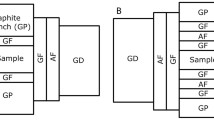Conclusions
-
1.
An investigation into the effect of various methods of application of electric energy and mechanical load on some characteristics of materials produced by electric sintering has shown that, at a given level of energy consumption, EDS ensures the most homogeneous structure, the highest density, and the best mechanical properties.
-
2.
Use of an alternating current leads to more effective sintering of peripheral regions. The reason for this is that sintering with an ac component is accompanied by the evolution of a large quantity of heat in the surface zone as a result of the skin effect. This heat counterbalances the heat lost from peripheral zones, thereby ensuring a more even temperature distribution over the specimen cross section.
-
3.
It has been established that the variation of porosity as a function of prepressing pressure has a non-monotonic character. In particular, for an electrolytic nickel powder with a particle size of < 50μ and an oxygen content of 0.06% this function passes through a minimum at a prepressing pressure of 16–20 kg/cm2.
-
4.
Experiments have shown that there exists a critical value of prepressing pressure above which uniform electric breakdown through interparticle gaps occurs in the whole volume of the compact.
Similar content being viewed by others
Literature cited
G. F. Taylor, US Pat. No. 1896854 (1933).
G. D. Cremer, US Pat. No. 2355954 (1944).
F. V. Lenel, Met.7, No. 1, 158 (1955).
L. A. Mel'nikov, Svar. Proizvod., No. 11 (1962).
E. V. Rymorov, V. M. Kogan, and I. D. Radomysel'skii, Poroshk. Metall., No. 7 (1974).
G. V. Samsonov and M. S. Koval'chenko, Hot Pressing [in Russian], Nauka Dumka, Kiev (1962).
Kiyoshi Inoue, Japan. Pat. No. 3241956 (1966).
R. W. Boesel, M. I. L. Jacobson, and I. S. Joshioka, Mater. Eng.,70, No. 4, 32 (1969).
Kiyoshi Inoue, Japan. Pat. No. 12491 (1968).
Kiyoshi Inoue, Japan. Pat. No. 14573 (1968).
B. M. Yavorskii and A. A. Detlaf, Textbook of Physics [in Russian], Nauka, Moscow (1968).
V. Finkelburg and G. Meeker, Electric Arcs and Thermal Plasma [Russian translation], IL, Moscow (1961).
Author information
Authors and Affiliations
Additional information
Translated from Poroshkovaya Metallurgiya, No. 10(166), pp. 19–26, October, 1976.
Rights and permissions
About this article
Cite this article
Raichenko, A.I., Kol'chinskii, M.Z. & Levina, D.A. Electric-discharge sintering of oxidized metal powders. Powder Metall Met Ceram 15, 754–759 (1976). https://doi.org/10.1007/BF00796189
Received:
Issue Date:
DOI: https://doi.org/10.1007/BF00796189




